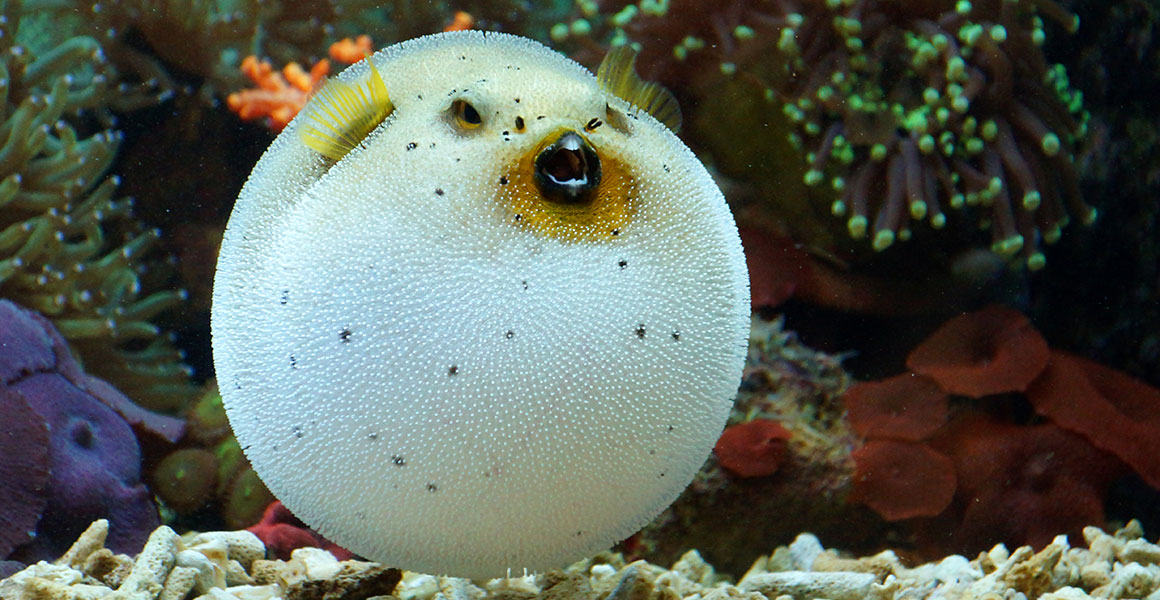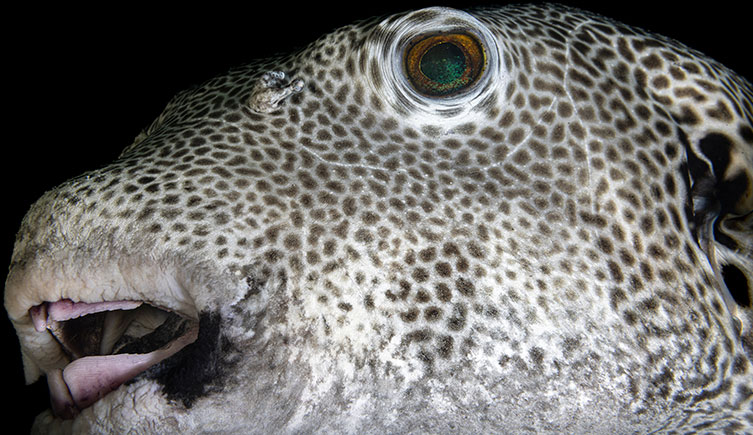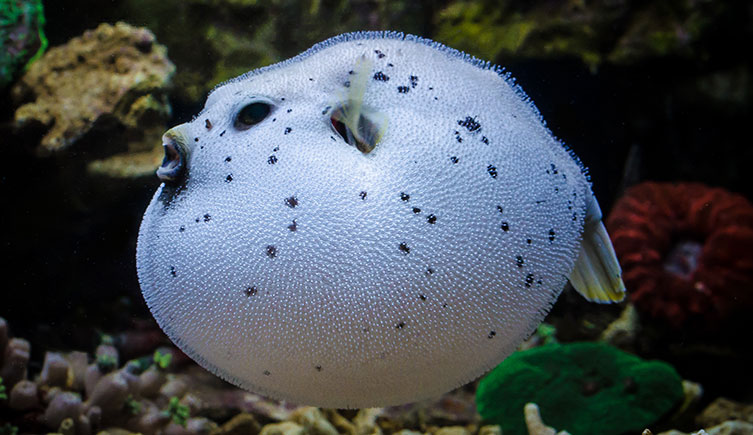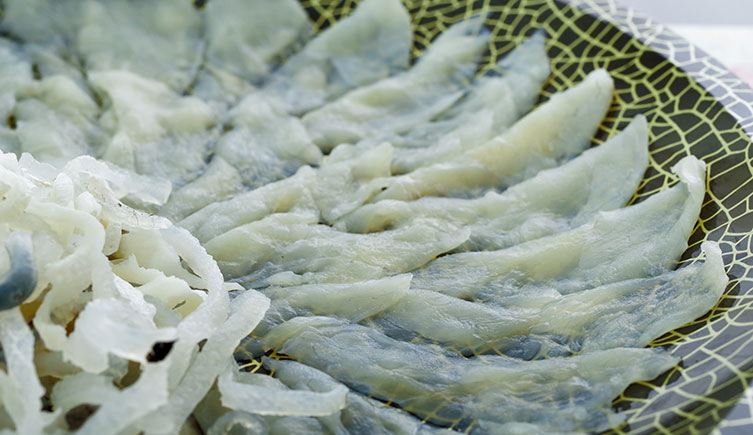Pufferfish have an iconic defence mechanism, but there’s more to these famous inflatables than meets the eye.
Their potent poison has a fearsome reputation, linking daredevil diners, drug-user dolphins and possible pain relief.

A blackspotted puffer, Arothron nigropunctatus, inflates to put off a potential predator. © Anastasia Mangindaan/ Shutterstock
Pufferfish have an iconic defence mechanism, but there’s more to these famous inflatables than meets the eye.
Their potent poison has a fearsome reputation, linking daredevil diners, drug-user dolphins and possible pain relief.
Fish scientists know the pufferfish family as Tetraodontidae, from the Greek words ‘tetra’ meaning four and ‘odont’ meaning teeth. This refers to large teeth at the front of their jaws, two on top and two on the bottom, that have fused to form a sort of beak. The fish use this to crush their tough-shelled prey including crustaceans and molluscs.

The smile of a starry puffer, Arothron stellatus, shows off its beak-like front teeth. © Kim_Briers/ Shutterstock
There are nearly 200 species of pufferfish. Many are known by common names that relate to the swollen shape they adopt to deter predators. Examples include puffers, blowfish, balloonfish, bubblefish, globefish and swellfish.
Pufferfish are primarily found in the world’s warm waters. Most pufferfish live in marine environments, but some live in brackish water. Around 30 species have also been discovered living in the freshwater river systems of South America, South Asia and Africa, including the Congo potato puffer, Tetraodon miurus, and the Indian pea puffer, Carinotetraodon travancoricus.
Fish in this family are relatively slow moving, reliant on small fins to power them through the water. This makes them an obvious target for predators. Yet only the toughest species such as tiger sharks, common octopus and sea snakes will take on a puffer thanks to some astounding adaptations.
Pufferfish inflate by ‘buccal pumping’: sucking water - or air if they’re out of the water - into their incredibly elastic stomachs. With specially modified gill muscles and a lack of ribs, the fish can swell to an almost spherical shape, three or four times their usual size.

Pufferfish prickles are visible when the animal inflates. © Dicky Asmoro/ Shutterstock
‘The skin of the stomach is also special in that the collagen fibres are arranged in parallel rows to allow it to stretch and return back to shape,’ explains Dr Rupert Collins, our Senior Curator of Fishes.
‘It was previously thought that pufferfish couldn’t breathe when inflated, which would limit the amount of time they could remain fully puffed. However, research on saddled pufferfish, Canthigaster valentini, suggests that they can indeed use their gills. But this doesn’t mean that they can stay inflated for long, because they use up to five times more oxygen than when resting.’
Scientists found that it takes a lot of energy for the fish to inflate, as shown by a five-hour recovery period post-puff.
‘Swimming while inflated is also more difficult and this further contributes to their oxygen debt,’ says Rupert. ‘So, while it’s a useful strategy to avoid being eaten, it’s not in their best interest to stay inflated for long, and most will quickly return to normal once danger has passed.’
Pufferfish aren’t the only group using this defensive trick, but alongside close relatives - porcupinefishes in the Diodontidae family - they’re certainly the most spectacular.
You can meet a large and impressive mbu puffer, Tetraodon mbu, on our behind-the-scenes Spirit Collection tour.
Not only does their ball-like shape make pufferfish harder to swallow, many also have spines. These spiky skin ornaments stick out when they blow up. The spines help to reinforce puffers’ stretchy skin as well as repelling anything trying to eat them.
Almost all pufferfish species have a final ferocious protective measure: a powerful neurotoxin. Tetrodotoxin - often shortened to TTX -was named for the fish but scientists have since found it in other species including the blue-ringed octopus. It’s produced by bacteria that live on food items the fish eats.
Rather than a venom they directly deploy, TTX is a poison carried passively by the fish. Puffers are immune to the toxin thanks to a genetic mutation, but they exploit its extreme effect on others. The highest concentrations of TTX are in the fishes’ liver, ovaries, skin and intestines.
Some male pufferfish appear to be attracted to TTX as a pheromone, detecting the miniscule amounts in eggs that need fertilisation. Larvae are also protected from predators by poison passed on by their mothers.

The saddled puffer, Canthigaster valentini - also known as the black saddled toby - advertises its poison. Prominent markings serve as a warning, called aposematism. © zaferkizilkaya/ Shutterstock
TTX works by binding to nerve cells and blocking essential signals between the brain and the body if eaten or breathed in. Beginning as numbness and tingling around the mouth, TTX poisoning can rapidly cause death in humans by paralysing the muscles essential for breathing.
One fish can have enough poison to kill multiple predators. Toxicity depends on the location, species and season. TTX is over 1,000 times more powerful than cyanide and there is currently no known antidote.
Recently, researchers have been investigating the use of low doses of TTX as a powerful painkiller to treat people suffering serious conditions including cancer, brain trauma and spinal cord injuries.
Despite a dangerous reputation, or possibly because of it, pufferfish is eaten in some parts of the world. As with many unusual delicacies, it’s often the experience rather than the taste that attracts diners, who report numbness, tingling and light-headedness - the initial symptoms of mild TTX poisoning.

Pufferfish sashimi is often served in a chrysanthemum design, symbolic of mortality. © beauty-box/ Shutterstock
The dish is a particular delicacy in Japan, where chefs prepare thin slices of raw puffer as sashimi. It’s called ‘fugu’ after the Takifugu group, notably the tiger puffer, Takifugu rubripes, and purple puffer, Takifugu porphyreus.
Pufferfish poisoning is the main cause of fatal food poisoning in Japan. The Japanese Ministry for Health reports that around 50 people are poisoned per year with a handful of deaths. These are primarily among anglers and amateurs who inexpertly prepare the dish themselves.
Fugu poisoning in Japan has decreased significantly over time. The Ministry for Health lists 18 species of pufferfish caught along the country’s coast alongside guidance about which parts are edible. It’s also a requirement that all chefs and restaurants handling pufferfish must be licenced.
The risk of poisoning from consuming properly prepared fugu is low and thrill-seekers will likely continue to seek out the infamous dish, as they have throughout history. Pufferfish remains have reportedly been found in shell middens - historic food waste heaps dating back more than 2,000 years.
It may not just be humans experimenting with pufferfish poison. Footage from a BBC documentary showed rough-toothed dolphins, Steno bredanensis, apparently toying with one of these toxic fish before entering a trance-like state, seemingly mesmerised by their own reflections at the water’s surface.
The behaviour was first reported in 1995 before being filmed in 2013 but it hasn’t yet been formally studied by scientists.
Our Principal Curator of Mammals Richard Sabin discusses the link between dolphins and pufferfish. Watch this video with audio description (1 minute 17 seconds).
Dolphins are known to use other sea creatures in their play sessions and study their own reflections, so it could just be curiosity. Yet there are also several examples in nature of animals seeking out intoxicating substances including fermenting fruit, poisonous millipedes and opium poppies.
Others argue that the risk of TTX poisoning makes it unlikely a smart mammal such as a dolphin would routinely play with pufferfish for fun. Especially since the powerful toxin has no mind-altering or relaxing effect, but a significant danger of suffocation.

The guineafowl puffer, Arothron meleagris, has three distinct colour variations. They include this eye-catching golden hue. © Dmitry Rukhlenko/ Shutterstock
Pufferfishes’ striking appearance makes them obvious stars for nature documentaries. Even when not inflated many species signal their scariness to would-be predators using bright colours.
Recently, filmmakers recorded a previously unseen mating behaviour that suggests we still have more to learn about these startling species.
In 1995, divers off the coast of Japan saw an elaborate, geometric sand sculpture on the seabed spanning two metres in diameter. They missed how it was created, so it was considered a mystery of the ocean, inviting comparisons to unexplained crop circles on land.
The riddle was solved in 2011 by researchers who identified the circle’s creator as Torquigener albomaculosus, a small, previously unrecorded species of pufferfish. Further study revealed that the fish completed the task non-stop over more than a week using just its tiny fins.
The pattern is a nest, created by a male to woo a female. Scientists suggest females are attracted by the craftsmanship and the building process moves fine sand particles into the centre of the nest, ideal for reproduction. Similar pufferfish nests have since been recorded off the western coast of Australia.
These recent revelations show how we can overlook even the most eye-catching of underwater species. Human ignorance is also a key threat to the future of pufferfish, particularly those living in coral reef environments under imminent threat from rising sea temperatures as a result of climate change.
‘Any way we can minimise our carbon footprint will benefit pufferfishes,’ says Rupert.
‘In tropical freshwaters the main threats are long-term habitat loss via hydroelectric dams and wider deforestation and landscape degradation. Charities such as International Rivers and World Wildlife Fund need help in raising awareness of these issues.’

Just how weird can the natural world be?

Explore life underwater and read about the pioneering work of our marine scientists.
Don't miss a thing
Receive email updates about our news, science, exhibitions, events, products, services and fundraising activities. We may occasionally include third-party content from our corporate partners and other museums. We will not share your personal details with these third parties. You must be over the age of 13. Privacy notice.
Follow us on social media